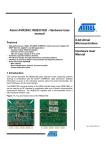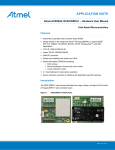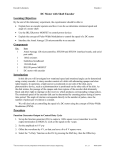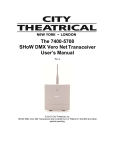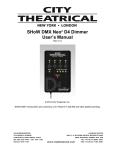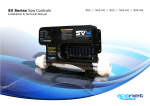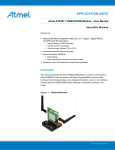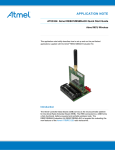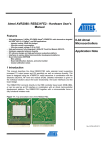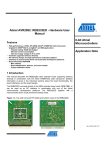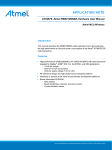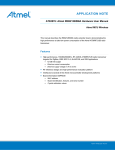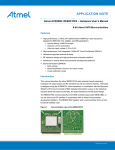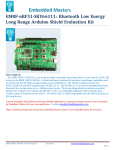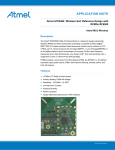Download Atmel AVR2162: REB233SMAD - Hardware User Manual
Transcript
APPLICATION NOTE Atmel AVR2162: REB233SMAD – Hardware User Manual 8-bit Atmel Microcontrollers Features • High-performance 2.4GHz RF-CMOS Atmel® AT86RF233 radio transceiver targeted for IEEE® 802.15.4, ZigBee®, ZigBee RF4CE, 6LoWPAN and ISM applications • Industry leading 101dB linkbudget • Ulta-low current consumption • Ultra-low supply voltage (1.8V to 3.6V) • • • • Hardware supported antenna diversity RF reference design and high-performance evaluation platform Interfaces to several of the Atmel microcontroller development platforms Board information EEPROM • MAC address • Board identification, features, and serial number • Crystal calibration values Introduction This manual describes the REB233SMAD radio extender board supporting antenna diversity in combination with the Atmel AT86RF233 radio transceiver. Detailed information is given in the individual sections about the board functionality, the board interfaces, and the board design. The REB233SMAD connects directly to the REB controller base board (REB-CBB), or can be used as an RF interface in combination with one of the Atmel microcontroller development platforms. The REB233SMAD together with a microcontroller forms a fully functional wireless node. Figure 1. REB233SMAD Radio Extender Board. 42006B−AVR−07/2012 Table of Contents 1. Disclaimer ............................................................................................ 3 2. Overview .............................................................................................. 3 3. Functional description .......................................................................... 3 3.1 Interface connector specification ....................................................................... 4 3.1.1 Atmel ATmega1281 configuration ....................................................... 4 3.1.2 Atmel ATmega644 configuration ......................................................... 5 3.2 ID EEPROM ...................................................................................................... 6 3.3 Supply current sensing...................................................................................... 7 3.4 Radio transceiver reference clock ..................................................................... 8 3.5 RF section ......................................................................................................... 8 4. PCB layout description ......................................................................... 9 4.1 PCB detail 1 – balanced RF pin fan out .......................................................... 10 4.2 PCB detail 2 – RF switch ................................................................................ 11 4.3 PCB detail 3 – crystal routing .......................................................................... 11 4.4 PCB detail 4 – transceiver analog GND routing .............................................. 12 4.5 PCB detail 5 – digital GND routing and shielding ............................................ 13 4.6 PCB detail 6 – transceiver RF tuning .............................................................. 14 4.7 Antenna connection ........................................................................................ 15 5. Mechanical description ...................................................................... 16 6. Electrical characteristics .................................................................... 17 6.1 Absolute maximum ratings .............................................................................. 17 6.2 Recommended operating range ...................................................................... 18 6.3 Current consumption ....................................................................................... 18 6.4 Duty cycle requirements .................................................................................. 19 7. Abbreviations ..................................................................................... 19 Appendix A. PCB design data ........................................................... 20 A.1 Schematic ....................................................................................................... 20 A.2 Assembly drawing ........................................................................................... 21 A.3 Bill of materials ................................................................................................ 21 Appendix B. Radio certification .......................................................... 23 B.1 United States (FCC) ........................................................................................ 23 B.2 Europe (ETSI) ................................................................................................. 24 B.3 Approved antenna ........................................................................................... 24 8. References ......................................................................................... 25 9. Revision history REB233SMAD PCBA .............................................. 26 10. EVALUATION BOARD/KIT IMPORTANT NOTICE ........................... 27 Atmel AVR2162: REB233SMAD – Hardware User Manual [APPLICATION NOTE] 42006B−AVR−07/2012 2 1. Disclaimer Typical values contained in this application note are based on simulations and testing of individual examples. Any information about third-party materials or parts was included in this document for convenience. The vendor may have changed the information that has been published. Check the individual vendor information for the latest changes. 2. Overview The radio extender board is assembled with an Atmel AT86RF233 radio transceiver [1] and equipped with two SMA connectors to support antenna diversity. External antennas can be connected to the SMA ports as well as RF measurement equipment for performance evaluation of the radio transceiver. The radio transceiver is able to switch between these two antenna ports to select the best receiving path in harsh multipath environments. The radio extender board was designed to interface to the Atmel microcontroller development or evaluation platforms (for example, Atmel STK®500). The microcontroller platform in combination with the REB provides an ideal way to: • Evaluate the outstanding radio transceiver performance, such as the excellent receiver sensitivity achieved at ultra-low current consumption • • Test the radio transceiver’s comprehensive hardware support of the IEEE 802.15.4™-2011 standard Test the radio transceiver’s enhanced feature set, which includes antenna diversity, AES, high data rate modes and reduce power consumption modes Figure 2-1 shows a development and evaluation setup using the REB controller base board (REB-CBB) [2] in combination with the REB233SMAD radio extender board; via SMA connectors which are assembled with quarter wave rotate and tilt antennas. Figure 2-1. The REB233SMAD connected to a REB-CBB. 3. Functional description The block diagram of the REB233SMAD radio extender board is shown in Figure 3-1. The power supply pins and all digital I/Os of the radio transceiver are routed to the 2 × 20-pin expansion connector to interface to a power supply and a microcontroller. Atmel AVR2162: REB233SMAD – Hardware User Manual [APPLICATION NOTE] 42006B−AVR−07/2012 3 The Atmel AT86RF233 antenna diversity (AD) feature supports the control of two antennas which can be assembled on top of the SMA connectors. A digital control pin (DIG1) is used to control an external RF switch selecting one of the two antennas. During the RX listening period, the radio transceiver continuously switches in between the two antennas autonomously, without the need for microcontroller interaction, if the AD feature is enabled [1]. Once an IEEE 802.15.4 synchronization header is detected, the antenna providing sufficient signal quality is selected to receive the remaining frame. This ensures reliability and robustness, especially in harsh environments with strong multipath fading effects [4]. Board-specific information such as board identifier, the node MAC address, and production calibration values are stored in an ID EEPROM. The SPI bus of the EEPROM is shared with the radio transceiver’s interface. Figure 3-1. REB233SMAD block diagram. JP1 DEVDD Protection GND TP7 TP6 DIG3 DIG4 X2 Balun RFSwitch RSTN DIG2 RFP AT86RF233 IRQ SLPTR RFN CLKM X3 ID EEPROM XTAL EXPAND1 DIG2 SPI XTAL2 XTAL1 DIG1 4 REB233SMAD 3.1 Interface connector specification The REB is equipped with a 2 × 20-pin, 100mil, expansion connector, X1. The pin assignment enables a direct interface to the REB-CBB [2]. Further, the interface connects to the Atmel STK500/501 microcontroller development platform to enable support for various Atmel 8-bit AVR® microcontrollers. The REB (2 × 20-pin X1 connector) is preconfigured to interface to an STK501 with an Atmel ATmega1281 or a Controller Base Board with an Atmel ATxmega 256A3 respectively. To operate the REB with an Atmel ATmega644 on STK500, the 0Ω resistors R10 through R18 must be removed and re-installed on the board manually as resistors R20 through R28 (see Appendix A). Other microcontroller development platforms need to be interfaced using a special adapter board. 3.1.1 Atmel ATmega1281 configuration Table 3-1. Default expansion connector mapping (ATmega1281 configuration). Pin# Function Pin# Function 1 GND 2 GND 3 n.c. 4 n.c. 5 n.c. 6 n.c. 7 n.c. 8 n.c. 9 n.c. 10 n.c. 11 n.c. 12 n.c. Atmel AVR2162: REB233SMAD – Hardware User Manual [APPLICATION NOTE] 42006B−AVR−07/2012 4 Pin# Function Pin# Function 13 n.c. 14 n.c. 15 n.c. 16 n.c. 18 n.c. 17 n.c., optionally XT1 (MCLK) 19 VCC 20 VCC 21 GND 22 GND 23 PB7 (open) 24 PB6 (open) 25 PB5 (RSTN) 26 PB4 (SLPTR) 27 PB3 (MISO) 28 PB2 (MOSI) 29 PB1 (SCLK) 30 PB0 (SEL) 31 PD7 (TP1) 32 PD6 (MCLK) 33 PD5 (TP2) 34 PD4 (DIG2) 35 PD3 (TP3) 36 PD2 (open) 37 PD1 (TP4) 38 PD0 (IRQ) 39 GND 40 EE#WP (write protect EEPROM) Note: 3.1.2 (1) 1. Possible by retrofitting a 0R assembly. Atmel ATmega644 configuration Table 3-2. Expansion connector mapping when assembled for ATmega644. Pin# Function Pin# Function 1 GND 2 GND 3 n.c. 4 n.c. 5 n.c. 6 n.c. 7 n.c. 8 n.c. 9 n.c. 10 n.c. 11 n.c. 12 n.c. 13 n.c. 14 n.c. 15 n.c. 16 n.c. 18 n.c. (1) 17 n.c., optionally XT1 (MCLK) 19 VCC 20 VCC 21 GND 22 GND 23 PB7 (SCLK) 24 PB6 (MISO) 25 PB5 (MOSI) 26 PB4 (SEL) 27 PB3 (open) 28 PB2 (RSTN) 29 PB1 (MCLK) 30 PB0 (open) 31 PD7 (SLPTR) 32 PD6 (DIG2) 33 PD5 (TP2) 34 PD4 (open) 35 PD3 (TP3) 36 PD2 (IRQ) 37 PD1 (TP4) 38 PD0 (open) 39 GND 40 EE#WP (write protect EEPROM) Note: 1. Possible by retrofitting a 0R assembly. Atmel AVR2162: REB233SMAD – Hardware User Manual [APPLICATION NOTE] 42006B−AVR−07/2012 5 3.2 ID EEPROM To identify the board type by software, an identification (ID) EEPROM, U5, is populated. Information about the board, the node MAC address and production calibration values are stored here. An Atmel AT25010B [3] with 128 × 8-bit organization and SPI bus is used because of its small package and low-voltage / low-power operation. The SPI bus is shared between the EEPROM and the transceiver. The select signal for each SPI slave (EEPROM, radio transceiver) is decoded with the reset line of the transceiver, RSTN. Therefore, the EEPROM is addressed when the radio transceiver is held in reset (RSTN = 0; see Figure 3-2). Figure 3-2. EEPROM access decoding logic (Atmel ATmega1281 configuration). PB5 (RSTN) RSTN PB0 (SEL) >1 SEL# /RST /SEL Transceiver AT86RF233 SPI PB1..3 (SPI) >1 #CS On-Board EEPROM The EEPROM data are written during board production testing. A unique serial number, the MAC address , and calibration values are stored. These can be used to optimize system performance. Note: 1. MAC addresses used for this package are Atmel property. The use of these MAC addresses for development purposes is permitted. Table 3-3 shows a detailed description of the EEPROM data structure. Table 3-3. ID EEPROM mapping. Address Name Type Description 0x00 MAC address uint64 MAC address for the 802.15.4 node, little endian byte order 0x08 Serial number uint64 Board serial number, little endian byte order 0x10 Board family uint8 Internal board family identifier 0x11 Revision uint8[3] Board revision number ##.##.## Board features, coded into seven bits 0x14 Feature uint8 7 Reserved 6 Reserved 5 External LNA 4 External PA 3 Reserved 2 Diversity 1 Antenna 0 SMA connector Atmel AVR2162: REB233SMAD – Hardware User Manual [APPLICATION NOTE] 42006B−AVR−07/2012 6 Address Name Type Description 0x15 Cal OSC 16MHz uint8 RF233 XTAL calibration value, register XTAL_TRIM 0x16 Cal RC 3.6V uint8 Atmel ATmega1281 internal RC oscillator calibration value @ 3.6V, register OSCCAL 0x17 Cal RC 2.0V uInt8 Atmel ATmega1281 internal RC oscillator calibration value @ 2.0V, register OSCCAL 0x18 Antenna gain Int8 Antenna gain [resolution 1/10dBi]. For example, 15 will indicate a gain of 1.5dBi. The values 00h and FFh are per definition invalid. Zero or -0.1dBi has to be indicated as 01h or FEh 0x20 Board name Char[30] Textual board description 0x3E CRC Uint16 16-bit CRC checksum, standard ITU-T generator polynomial G16(x) = x16 + x12 + x5 + 1 Figure 3-3. Example EEPROM dump. -----| EEPROM dump |-------------0000 - 8F 5C 17 FF FF 25 04 00 70 02 00 00 40 00 00 00 .\...%..p...@... 0010 - 00 08 01 00 05 04 A9 AA 00 FF FF FF FF FF FF FF ................ 0020 - 52 45 42 32 33 33 53 4D 41 44 00 00 00 00 00 00 REB233SMAD...... 0030 - 00 00 00 00 00 00 00 00 00 00 00 00 00 00 F5 06 ................ 0040 - FF FF FF FF FF FF FF FF FF FF FF FF FF FF FF FF ................ 0050 - FF FF FF FF FF FF FF FF FF FF FF FF FF FF FF FF ................ 0060 - FF FF FF FF FF FF FF FF FF FF FF FF FF FF FF FF ................ 0070 - FF FF FF FF FF FF FF FF FF FF FF FF FF FF FF FF ................ ---------------------------------- 3.3 Supply current sensing A jumper, JP1, is placed in the supply voltage trace to offer an easy way for current sensing. The current consumption of all circuitry connected to the supply domains DEVDD/EVDD such as AT86RF233 and AT25010B can be measured by connecting an ampere meter instead of the jumper bridge JP1, see Figure 3-4 on page 8 The power supply pins of the radio transceiver are protected against overvoltage stress and reverse polarity at the X1 connector pins (net CVTG, net DGND) using a Zener diode, D1, and a thermal fuse, F1, (see Appendix A). This is required because the Atmel STK500 will provide 5V as default voltage, and the board can also be mounted with reverse polarity. Depending on the actual supply voltage, the diode D1 can consume several milliamperes. This has to be considered when the current consumption of the whole system is measured. In such a case, D1 should be removed from the board. To achieve the best RF performance, the analog (EVDD) and digital (DEVDD) supply are separated from each other by a CLC PI-filter. Digital and analog ground planes are connected together on the bottom layer, underneath the radio transceiver IC. Further details are described in Section 4, page 9. Note: All components connected to nets DEVDD/EVDD contribute to the total current consumption. While in radio transceiver SLEEP state, most of the supply current is drawn by the 1MΩ pull-up resistor, R24, connected to the ID EEPROM and the EEPROM standby current. Atmel AVR2162: REB233SMAD – Hardware User Manual [APPLICATION NOTE] 42006B−AVR−07/2012 7 Figure 3-4. Power supply routing. 3.4 Radio transceiver reference clock The integrated radio transceiver is clocked by a 16MHz reference crystal, Q1. The 2.4GHz modulated signal is derived from this clock. Operating the node according to IEEE 802.15.4 [5], the reference frequency must not exceed a deviation of ±40ppm. The absolute frequency is mainly determined by the external load capacitance of the crystal, which depends on the crystal type and is given in its datasheet. The radio transceiver reference crystal, Q1, shall be isolated from fast switching digital signals and surrounded by a grounded guard trace to minimize disturbances of the oscillation. Detailed layout considerations can be found in Section 4.3, page 11. The REB uses a Siward SX4025 crystal with two load capacitors of 10pF each. To compensate for fabrication and environment variations, the frequency can be further tuned using the radio transceiver register XOSC_CTRL (0x12) (refer to [1], Section References). The REB production test guarantees a tolerance of within +20ppm and -5ppm. The correction value, to be applied to TRX register XOSC_CTRL (0x12), is stored in the onboard EEPROM (see Section 3.2, page 6). The reference frequency is also available at pin CLKM of the radio transceiver and, depending on the related register setting; it is divided by an internal prescaler. CLKM clock frequencies of 16MHz, 8MHz, 4MHz, 2MHz, 1MHz, 250kHz, or 62.5kHz are programmable (refer to [1]). The CLKM signal is filtered by a low-pass filter to reduce harmonic emissions within the 2.4GHz ISM band. The filter is designed to provide a stable 1MHz clock signal with correct logic level to a microcontroller pin with sufficiently suppressed harmonics. CLKM frequencies above 1MHz require a redesign of R25 and C40. In case of RC cut-off frequency adjustments, depending on the specific load and signal routing conditions, one may observe performance degradation of channel 26. Note: Channel 26 (2480MHz) is affected by the following harmonics: 155 × 16MHz or 310 × 8MHz. By default, CLKM is routed to a microcontroller timer input; check the individual configuration resistors in the schematic drawing. To connect CLKM to the microcontroller main clock input, assemble R3 with a 0Ω resistor. 3.5 RF section The Atmel AT86RF233 radio transceiver incorporates all RF and base band critical components, necessary to transmit and receive signals according to IEEE 802.15.4 or proprietary ISM data rates. The balun, B1, performs the differential to single-ended conversion of the RF signal to connect the AT86RF233 to the RF switch, U1. The RF switch is controlled by the radio transceiver output, DIG1, and selects one of the two antennas. The output signal is routed to the edge mounted SMA connectors, X2 and X3. The /4 antennas, provided with the board can rotate and tilt. Detailed information about the antenna diversity feature are given in [1] and [4]. Atmel AVR2162: REB233SMAD – Hardware User Manual [APPLICATION NOTE] 42006B−AVR−07/2012 8 To estimate the effective output power for the SMA connector reference plane, the balun, the switch and transmission line losses have to be taken into account. Therefore, in worst case, the SMA connector output power can be up to 1.5dB below the datasheet value, specified for the AT86RF233. Insertion loss data for the individual components can be obtained from associated datasheets. Please check the part reference inside the BOM in section A.3. 4. PCB layout description This section describes critical layout details to be carefully considered during a PCB design. The PCB design requires an optimal solution for the following topics: • Create a solid ground plane as a stable reference for the transceiver, the antenna and the transmission lines. The PCB has to be considered as a part of the antenna; it interacts with the radiated electromagnetic wave • • Isolate digital noise from the antenna and the radio transceiver to achieve optimum range and RF performance • Reduce any kind of spurious emissions below the limits set by the individual regulatory organizations Isolate digital noise from the 16MHz reference crystal to achieve optimum transmitter and receiver performance The REB233SMAD PCB design further demonstrates a low-cost, two-layer PCB solution without the need of an inner ground plane. The drawing in Figure 4-1 shows critical sections using numbered captions. Each caption number has its own subsection below with detailed information. Figure 4-1. Board layout sections with detail descriptions. Atmel AVR2162: REB233SMAD – Hardware User Manual [APPLICATION NOTE] 42006B−AVR−07/2012 9 4.1 PCB detail 1 – balanced RF pin fan out Figure 4-2. Board layout – RF pin fan out. The Atmel AT86RF233 antenna port should be connected to a 100Ω load with a small series inductance of 1nH to 2nH. This is achieved with the connection fan out in between the IC pins and the filter balun combination B1. The trace width is kept small at 0.2mm for a length of approximately 1.5mm. The REB233SMAD is a two-layer FR4 board with a thickness of 1.5mm. Therefore, the distributed capacitance between top and bottom is low, and transmission lines are rather inductive. B1 has the DC blocking built in. Only pin 2 requires DC blocking within its GND connection since this is considered as bias access pin. The distance of 1.5mm in between B1 and U3 also allows GND vias for pin 3 and pin 6 of the AT86RF233. The GND connection in a low distance has a small parasitic inductance and is therefore desirable for the RF port. Atmel AVR2162: REB233SMAD – Hardware User Manual [APPLICATION NOTE] 42006B−AVR−07/2012 10 4.2 PCB detail 2 – RF switch Figure 4-3. Board layout – RF switch. The RF switch requires a solid grounding to achieve the full isolation and RF filter capacitors for the control pins. A parasitic inductance within the ground connection may reduce the RF isolation of the switch output in the off state. To achieve a hard, low-impedance ground connection, several vias are placed on each side of the ground pad. The ground pad is connected to the top layer ground plane in addition. Blocking capacitors C24 and C25 are placed as close as possible to the RF switch to short any control line noise. Noise interfering on the control pins may cause undesired modulation of the RF signal. Therefore these parts are marked as noise shunt. C11 and C12 will block any DC voltage on the RF line. On the input side, C28, next to the balun provides the required DC blocking. 4.3 PCB detail 3 – crystal routing The reference crystal PCB area requires optimization to minimize external interference and to keep any radiation of 16MHz harmonics low. Since the board design incorporates a shield, the crystal housing has been tied hard to ground. This method will minimize the influence of external impairments such as burst and surge. To prevent crosstalk, the crystal is encircled by a ring of ground traces and vias. Special care has to be taken in the area between the IRQ line and the crystal. Depending on the configuration, the interrupt may be activated during a frame receive. Crosstalk into the crystal lines would increase the phase noise and therefore reduce the signal to noise ratio. Atmel AVR2162: REB233SMAD – Hardware User Manual [APPLICATION NOTE] 42006B−AVR−07/2012 11 Figure 4-4. Board layout – XTAL section. The reference crystal and its load capacitors C37/38 form the resonator circuit. These capacitors are to be placed close to the crystal. The ground connection in between the capacitors should be a solid copper area right underneath the crystal, including the housing contacts. 4.4 PCB detail 4 – transceiver analog GND routing With the Atmel AT86RF233, consider pins 3, 6, 27, 30, 31, and 32 as analog ground pins. Pin 7 is an exception and can be connected to the central paddle like the other analog ground pins. Analog ground pins are to be routed to the paddle underneath the IC. The trace width has to be similar to the pad width when connecting the pads, and increase, if possible, in some distance from the pad. This measure will decrease the parasitic inductance as far as possible. Each ground pin should be connected to the bottom plane with at least one via. Move the vias as close to the IC as possible. It is always desired to integrate the single-pin ground connections into polygon structures after a short distance. Top, bottom, and, on multilayer boards, the inner ground planes, should be tied together with a grid of vias. When ground loops are smaller than one tenth of the wavelength, it is safe to consider this as a solid piece of metal. Atmel AVR2162: REB233SMAD – Hardware User Manual [APPLICATION NOTE] 42006B−AVR−07/2012 12 Figure 4-5. Board layout – transceiver GND. The soldering technology used allows the placement of small vias (0.15mm drill) within the ground paddle underneath the chip. During reflow soldering, the vias get filled with solder, having a positive effect on the connection cross section. The small drill size keeps solder losses within an acceptable limit. During the soldering process vias should be open on the bottom side to allow enclosed air to expand. 4.5 PCB detail 5 – digital GND routing and shielding With the Atmel AT86RF233, consider pins 12, 16, 18, and 21 as digital ground pins. Digital ground pins are not directly connected to the center paddle. Digital ground pins may carry digital noise from I/O pad cells or other digital processing units within the chip. In case of a direct paddle connection, impedances of the paddle ground vias could cause a small voltage drop for this noise and may result in an increased noise level transferred to the analog domain. There is a number of pro’s and con’s when it comes to the shielding topic. The major con’s are: • • • Cost of the shield Manufacturing effort Inaccessibility for test and repair The number of pro’s might be longer but the cost argument is often very strong. However, the reasons to add the shield for this reference design are: • • • Shield is required for a certification in Japan Shield is recommended for FCC certification in North America Increased performance Atmel AVR2162: REB233SMAD – Hardware User Manual [APPLICATION NOTE] 42006B−AVR−07/2012 13 Figure 4-6. Board layout – GND and shield. Besides the function to provide supply ground to the individual parts, the ground plane has to be considered as a counterpart for the antenna. Such an antenna base plate is required to achieve full antenna performance. It has to be a continuous, sustained metal plate for that purpose. The shield, covering the electronic section will help to form this antenna base plate. For that reason, any unused surface should be filled with a copper plane and connected to the other ground side using sufficient through hole contacts. Larger copper areas should also be connected to the other side layer with a grid of vias. This will form kind of a RF sealing for the FR4 material. Any wave propagation in between the copper layers across the RF4 will become impossible. This way, for an external electromagnetic field, the board will behave like a coherent piece of metal. When a trace is cutting the plane on one side, the design should contain vias along this trace to bridge the interrupted ground on the other side. Place vias especially close to corners and necks to connect lose polygon ends. The pads where the shield is mounted also need some attention. The shield has to be integrated in the ground planes. Vias, in a short distance to the pads, will ensure a low impedance connection and also close the FR4 substrate as mentioned above. 4.6 PCB detail 6 – transceiver RF tuning The REB233SMAD implements a tuning structure to optimize the transceiver matching. A transmission line in combination with a capacitor is used to vary the load impedance. Under normal conditions only one capacitor is assembled at position C23, C26, or C27. These three positions allow varying the position of the capacitor along the transmission line. The capacitance value and the position of the capacitor can be changed to tune the system. Atmel AVR2162: REB233SMAD – Hardware User Manual [APPLICATION NOTE] 42006B−AVR−07/2012 14 Figure 4-7. Board layout – transceiver RF tuning. During tuning the best compromise in between RX and TX performance has to be found. Tuning should be done for the receiver first. First step should be to verify the 50Ω matching at U1, pin 5. To measure this impedance with a network analyzer, U1 needs to be removed and a 1mm rigid cable should be connected to pin 5. Measurements from X2 and X3 are much harder to calibrate. The transceiver has to be set to state RX_ON for that measurement. If the transceiver is not powered and is in a state other than RX_ON, the measured S11 will not show reasonable impedance. After that, the capacitor position and value can be slightly varied. The reception performance should be measured using a packet error test. Typical tuning capacitor values are in between 0.5pF and 1pF. To simplify the tuning, the receiver input power should be adjusted to a value where a PER of ~1% can be measured. For the measurement 5.000 to 10.000 frames should be used to get a clear PER value. After a board tuning change the PER should be measured with the same environment as before. Now the new sensitivity can be evaluated based on a simple rule of thumb. A PER change by one decimal power (from 1% up to 10%, or down to 0.1%) corresponds in average with a 1dB change in sensitivity. The tuning measurements have to take the whole frequency band into account. The matching point for best sensitivity can, but may not be identical with the best S11 matching point. The matching point for the lowest noise figure will be different from the best S11 matching point that can be measured. When satisfying reception sensitivity was achieved, the transmitter performance should be tested as well for the current tuning step. Main parameters are transmitting power, EVM, spurious emissions and performance flatness over the whole frequency band. Goal is to maximize the link budged, calculated from sensitivity and transmits power. 4.7 Antenna connection The board was constructed with the two SMA connectors at the left and right side to allow antennas to be connected. A good choice in between flexibility and performance is a quarter wave antenna with rotate and tilt option. Antenna origin details: Vendor: Tekfun Co., Ltd. Type: M35-S, Swivel SMA male Atmel AVR2162: REB233SMAD – Hardware User Manual [APPLICATION NOTE] 42006B−AVR−07/2012 15 Figure 4-8. Antenna tuning structure. The board design implements additional footprints for a pi-network to tune short antennas correctly against the board ground plane. For the antenna delivered with the board, this is not required and therefore C13, C14, C15, and C16 are unassembled. 5. Mechanical description The REB233SMAD is manufactured using a low-cost, two-layer printed circuit board. All components and connectors are mounted on the top side of the board. The format was defined to fit the EXPAND1 connector on the Atmel AVR STK500/STK501 microcontroller evaluation board. The upright position was chosen for best antenna performance. Atmel AVR2162: REB233SMAD – Hardware User Manual [APPLICATION NOTE] 42006B−AVR−07/2012 16 Figure 5-1. Mechanical outline (dimensions in mm). Table 5-1. RED233SMAD mechanical dimensions. Dimension Value Width x 57mm Width y 61mm 6. Electrical characteristics 6.1 Absolute maximum ratings Stresses beyond the values listed in Table 6-1 may cause permanent damage to the board. This is a stress rating only and functional operation of the device at these or any other conditions beyond those indicated in the operational sections of this manual are not implied. Exposure to absolute maximum rating conditions for extended periods may affect device reliability. For more details about these parameters, refer to individual datasheets of the components used. Atmel AVR2162: REB233SMAD – Hardware User Manual [APPLICATION NOTE] 42006B−AVR−07/2012 17 Table 6-1. Absolute maximum ratings. No. Parameter 7.1.1 Storage temperature range 7.1.2 Humidity 7.1.3 Supply voltage -0.3 +3.6 V 7.1.4 EXT I/O pin voltage -0.3 VCC + 0.3 V 7.1.5 Supply current from batteries +70 A 7.1.6 Condition -40 Sum over all power pins (1) Maximum 1. 6.2 Recommended operating range Unit +85 °C 90 % r.H. 0 Note: mA Keep power switch off or remove battery from REB-CBB when external power is supplied. Recommended operating range. No. Parameter Condition 7.2.1 Operating temperature range Crystal within ±40ppm 7.2.2 Supply voltage (VCC) 6.3 Typical Non-condensing Battery Charge current Table 6-2. Minimum Minimum Typical -20 1.8 3.0 Maximum Unit +70 °C 3.6 V Current consumption Test conditions (unless otherwise stated): VDD = 3.0V, TOP = 25°C Table 6-3 lists current consumption values for typical scenarios of a complete system composed of REB-CBB and REB233. The Zener diode D1 has been removed as described above. Table 6-3. Current consumption of REB-CBB populated with REB233. No. Parameter Condition Minimum Typical 7.3.1 Supply current MCU @ power down, transceiver in state SLEEP, serial flash in Deep-Sleep 17 (1) Supply current MCU @ 2MHz, transceiver in state TRX_OFF 3 (1) 7.3.3 Supply current MCU @ 16MHz (int. RC 32MHz), transceiver in state TRX_OFF 15 (1) 7.3.4 Supply current MCU @ 16MHz (int. RC 32MHz), transceiver in state RX_ON 28 (1) 7.3.5 Supply current MCU @ 16MHz (int. RC 32MHz), transceiver in state BUSY_TX 26 (1) 1. Unit µA 7.3.2 Note: Maximum mA mA mA mA Measurement results with D1 removed. Atmel AVR2162: REB233SMAD – Hardware User Manual [APPLICATION NOTE] 42006B−AVR−07/2012 18 6.4 Duty cycle requirements Table 6-4. TX operating condition. No. Parameter Condition 7.4.1 TX Duty Cycle OQPSK(1) over 100ms IEEE802.15.4 channel 26 Note: 1. Minimum Typical Maximum 31 Unit % To ensure FCC compliant operation for the OQPSK operating mode in IEEE802.51.4 channel 26, the TX duty cycle has to be equal or below the specified maximum value under normal and extreme conditions. The duty cycle for other channels is not restricted. For DCSS operation the maximum limit is 3% at frequency 2.481GHz. For further details refer to VNR-E33SD-X5B-00 FCC test report. 7. Abbreviations 802.15.4 - IEEE 802.15.4-standard, applicable to low-rate wireless Personal Area Network AD - Antenna diversity AES - Advanced encryption standard BB - Baseband CBB/REB-CBB - Controller base board CRC - Cyclic redundancy check ETSI - European Telecommunications Standards Institute EVM - Error Vector Magnitude FCC - Federal Communications Commission ISM - Industrial, scientific and medical (frequency band) LNA - Low-noise amplifier MAC - Medium access control NWA - Network analyzer PA - Power amplifier PER - Packet error rate R&TTE - Radio and Telecommunications Terminal Equipment (Directive of the European Union) REB - Radio extender board RF - Radio frequency RX - Receiver S11 - Input port voltage reflection coefficient, one of the scattering (S-)parameters, describes the input matching to the reference system (50 or 75 Ohms) SMA - Sub-miniature-A (connection) SPI - Serial peripheral interface TX - Transmitter XTAL - Crystal Atmel AVR2162: REB233SMAD – Hardware User Manual [APPLICATION NOTE] 42006B−AVR−07/2012 19 Appendix A. A.1 PCB design data Schematic Figure 7-1. REB233SMAD schematic. Atmel AVR2162: REB233SMAD – Hardware User Manual [APPLICATION NOTE] 42006B−AVR−07/2012 20 A.2 Assembly drawing Figure 7-2. REB233SMAD assembly drawing. A.3 Bill of materials Table 7-1. Bill of materials. Qty. Designator Description Footprint Manuf. Part# Manufacturer Comment 1 X1 Pin header 2×20 90 degree JP_2×20_90°_ Top_Invers 1007-121-40 CAB HEADER-20X2 2 X2, X3 End Launch Jack Receptacle SMA Board Edge, 1.6mm 142-0711-821 EMERSON Round Contact 1 U5 EEPROM MiniMap-8-2X3 AT25010BMAHL-T Atmel AT25010B 1 U4 Logic gate SC70-8 NV7WP32K8X Fairchild NC7WP32K8X 1 U3 802.15.4 2.4GHz radio transceiver MLF-32 AT86RF233 Atmel AT86RF233 2 U2, U6 Dual INV, ULP SC70-6 NC7WV04P6X Fairchild NC7WV04 1 U1 RF switch SC70-6 AS222-92 SkyWorks AS222-92 Atmel AVR2162: REB233SMAD – Hardware User Manual [APPLICATION NOTE] 42006B−AVR−07/2012 21 Qty. Designator Description Footprint Manuf. Part# Manufacturer Comment 1 SH1 SMT RF Shield Shield-BMIS LT08AD4303F Laird Frame&Lid 9 R5, R7, R10, R12, R14, R17, R19, R21, R23 Resistor 0603H0.5 Samsung 0Ω 2 R29, R30 Resistor 0402A Samsung 0Ω 1 R32 Resistor 0402A Samsung 22Ω 1 R25 Resistor 0402A Samsung 470Ω 2 R8, R15 Resistor 0402A Samsung 2.2kΩ 2 R27, R28 Resistor 0402A Samsung 10kΩ 2 R24, R26 Resistor 0402A Samsung 1MΩ 1 Q1 Crystal 16MHz XTAL_4X2_5_ Small XTL551150NLE16.0MHz-9.0R Siward SX-4025 16MHz 1 L1 SMT ferrite bead 0603H0.8 74279263 Würth 220Ω@100MHz 1 JP1 Jumper 2-pole JP_2x1 1001-121-002 CAB JP-2 1 J3 Jumper cap 3300096 CAB 1 F1 PTC fuse 1812 miniSMDC020 Raychem miniSMDC020 1 D1 Z-Diode DO-214AC BZG05C3V9 Vishay BZG05C3V9 2 C37, C38 Capacitor 0402A Panasonic 10pF/5% 2 C35, C36 Capacitor 0402A Kemet 1µF 6 C30, C31, C32, C33, C34, C39 Capacitor 0402A Murata 100n 6 C11, C12, C24, C25, C28, C29 Capacitor 0402A Kyovera-elco 22pF 1 C40 Capacitor 0402A Murata 2.2pF 1 C23 Capacitor 0402A Generic G0G 1.2pF 1 B1 Balun 0805-6 JTI Johanson 2.4GHz Filtered Balun 2450FB15L0001E Atmel AVR2162: REB233SMAD – Hardware User Manual [APPLICATION NOTE] 42006B−AVR−07/2012 22 Appendix B. Radio certification The wireless radio node consisting of: 1. 2. 3. 4. Radio Extender Board REB233SMAD (as described in this application note), assembled with Two 2.4GHz Omni Rubber Antennas M35-S [9], mounted on a REB Controller Base Board (REB-CBB [2]), which hosts an application firmware available with Atmel AVR2025: IEEE 802.15.4 MAC Software Package [10] has received regulatory approvals for modular devices in the United States and European countries. The wireless node is shown in Figure 2-1. B.1 United States (FCC) Compliance Statement (Part 15.19) The device complies with Part 15 of the FCC rules. To fulfill FCC Certification requirements, an Original Equipment Manufacturer (OEM) must comply with the following regulations: • The modular transmitter must be labeled with its own FCC ID number, and, if the FCC ID is not visible when the module is installed inside another device, the outside of the device into which the module is installed must also display a label referring to the enclosed module • This exterior label can use wording such as the following. Any similar wording that expresses the same meaning may be used Contains FCC-ID: VNR-E33SD-X5B-00 This device complies with Part 15 of the FCC Rules. Operation is subject to the following two conditions: (1) this device may not cause harmful interference, and (2) this device must accept any interference received, including interference that may cause undesired operation. Use in portable exposure conditions (FCC 2.1093) requires separate equipment authorization. Modifications not expressly approved by this company could void the user's authority to operate this equipment (FCC Section 15.21). Compliance Statement (Part 15.105(b)) This equipment has been tested and found to comply with the limits for a Class B digital device, pursuant to Part 15 of the FCC Rules. These limits are designed to provide reasonable protection against harmful interference in a residential installation. This equipment generates uses and can radiate radio frequency energy and, if not installed and used in accordance with the instructions, may cause harmful interference to radio communications. However, there is no guarantee that interference will not occur in a particular installation. If this equipment does cause harmful interference to radio or television reception, which can be determined by turning the equipment off and on, the user is encouraged to try to correct the interference by one or more of the following measures: • • • • Reorient or relocate the receiving antenna Increase the separation between the equipment and receiver Connect the equipment into an outlet on a circuit different from that to which the receiver is connected Consult the dealer or an experienced radio/TV technician for help Atmel AVR2162: REB233SMAD – Hardware User Manual [APPLICATION NOTE] 42006B−AVR−07/2012 23 IMPORTANT FCC NOTICE to USERS Warning: Changes or modifications not expressly approved by this company could void the user’s authority to operate the equipment. B.2 Europe (ETSI) If the device is incorporated into a product, the manufacturer must ensure compliance of the final product to the European harmonized EMC and low-voltage/safety standards. A Declaration of Conformity must be issued for each of these standards and kept on file as described in Annex II of the R&TTE Directive. The manufacturer must maintain a copy of the device documentation and ensure the final product does not exceed the specified power ratings, and/or installation requirements as specified in the user manual. If any of these specifications are exceeded in the final product, a submission must be made to a notified body for compliance testing to all required standards. The “CE“ marking must be affixed to a visible location on the OEM product. The CE mark shall consist of the initials "CE" taking the following form: • If the CE marking is reduced or enlarged, the proportions given in the above graduated drawing must be respected • The CE marking must have a height of at least 5mm except where this is not possible on account of the nature of the apparatus • The CE marking must be affixed visibly, legibly, and indelibly More detailed information about CE marking requirements you can find at "DIRECTIVE 1999/5/EC OF THE EUROPEAN PARLIAMENT AND OF THE COUNCIL" on 9 March 1999 at section 12. B.3 Approved antenna The device has been tested and approved for use with the antenna listed below. The device may be integrated with other custom design antennas which OEM installer must authorize with respective regulatory agencies. The used antenna is connected to the radio module via an SMA connection. Table 7-2. Approved antenna. Manufacturer Description Model Frequency Connector TEKFUN Co. ¼-wave swivel SMA Male antenna M35-S 2400MHz Male SMA Atmel AVR2162: REB233SMAD – Hardware User Manual [APPLICATION NOTE] 42006B−AVR−07/2012 24 8. References [1] AT86RF233; Ultra-low Power, 2.4GHz Transceiver for ZigBee, IEEE 802.15.4, 6LoWPAN, RF4CE, SP100, Wireless HART and ISM Applications; Datasheet doc. no. 8351; Atmel Corporation [2] AVR2042: REB Controller Base Board – Hardware User Guide; Application Note doc. no. 8334; Atmel Corporation [3] AT25010B; SPI Serial EEPROM; Datasheet doc. no. 8707; Atmel Corporation. [4] AVR2021: AT86RF231 Antenna Diversity; Application Note doc. no. 8158; Atmel Corporation [5] IEEE Std 802.15.4™-2006: Wireless Medium Access Control (MAC) and Physical Layer (PHY) Specifications for Low-Rate Wireless Personal Area Networks (LR-WPANs) [6] FCC Code of Federal Register (CFR); Part 47; Section 15.35, Section 15.205, Section 15.209, Section 15.232, Section 15.247, and Section 15.249. United States. [7] ETSI EN 300 328, Electromagnetic Compatibility and Radio Spectrum Matters (ERM); Wideband Transmission Systems; Data transmission equipment operating in the 2.4GHz ISM band and using spread spectrum modulation techniques; Part 1-3. [8] ARIB STD-T66, Second Generation Low Power Data Communication System/Wireless LAN System 1999.12.14 (H11.12.14) Version 1.0. [9] M35-S; Swivel SMA Male antenna for 2.4GHz; Technical specification; http://www.tekfun.com.tw/product.php?mode=show&cid=28&pid=255; TEKFUN CO., LTD. [10] Atmel AVR2025: IEEE 802.15.4 MAC Software Package – User Guide; Application Note doc. no. 8412; Atmel Corporation Atmel AVR2162: REB233SMAD – Hardware User Manual [APPLICATION NOTE] 42006B−AVR−07/2012 25 9. Revision history REB233SMAD PCBA Version Description A09- 1303/01 Initial revision Atmel AVR2162: REB233SMAD – Hardware User Manual [APPLICATION NOTE] 42006B−AVR−07/2012 26 10. EVALUATION BOARD/KIT IMPORTANT NOTICE This evaluation board/kit is intended for use for FURTHER ENGINEERING, DEVELOPMENT, DEMONSTRATION, OR EVALUATION PURPOSES ONLY. It is not a finished product and may not (yet) comply with some or any technical or legal requirements that are applicable to finished products, including, without limitation, directives regarding electromagnetic compatibility, recycling (WEEE), FCC, CE or UL (except as may be otherwise noted on the board/kit). Atmel supplied this board/kit “AS IS,” without any warranties, with all faults, at the buyer’s and further users’ sole risk. The user assumes all responsibility and liability for proper and safe handling of the goods. Further, the user indemnifies Atmel from all claims arising from the handling or use of the goods. Due to the open construction of the product, it is the user’s responsibility to take any and all appropriate precautions with regard to electrostatic discharge and any other technical or legal concerns. EXCEPT TO THE EXTENT OF THE INDEMNITY SET FORTH ABOVE, NEITHER USER NOR ATMEL SHALL BE LIABLE TO EACH OTHER FOR ANY INDIRECT, SPECIAL, INCIDENTAL, OR CONSEQUENTIAL DAMAGES. No license is granted under any patent right or other intellectual property right of Atmel covering or relating to any machine, process, or combination in which such Atmel products or services might be or are used. Mailing Address: Atmel Corporation, 2325 Orchard Parkway, San Jose, CA 95131 Copyright © 2012, Atmel Corporation Atmel AVR2162: REB233SMAD – Hardware User Manual [APPLICATION NOTE] 42006B−AVR−07/2012 27 Atmel Corporation Atmel Asia Limited Atmel Munich GmbH Atmel Japan G.K. 1600 Technology Drive Unit 01-5 & 16, 19F Business Campus 16F Shin-Osaki Kangyo Bldg. San Jose, CA 95110 BEA Tower, Millennium City 5 Parkring 4 1-6-4 Osaki, Shinagawa-ku USA 418 Kwun Tong Road D-85748 Garching b. Munich Tokyo 141-0032 Tel: (+1)(408) 441-0311 Kwun Tong, Kowloon GERMANY JAPAN Fax: (+1)(408) 487-2600 HONG KONG Tel: (+49) 89-31970-0 Tel: (+81)(3) 6417-0300 www.atmel.com Tel: (+852) 2245-6100 Fax: (+49) 89-3194621 Fax: (+81)(3) 6417-0370 Fax: (+852) 2722-1369 © 2012 Atmel Corporation. All rights reserved. / Rev.: 42006B−AVR−07/2012 Atmel®, Atmel logo and combinations thereof, Enabling Unlimited Possibilities®, AVR®, STK®, and others are registered trademarks or trademarks of Atmel Corporation or its subsidiaries. Other terms and product names may be trademarks of others. Disclaimer: The information in this document is provided in connection with Atmel products. No license, express or implied, by estoppel or otherwise, to any intellectual property right is granted by this document or in connection with the sale of Atmel products. EXCEPT AS SET FORTH IN THE ATMEL TERMS AND CONDITIONS OF SALES LOCATED ON THE ATMEL WEBSITE, ATMEL ASSUMES NO LIABILITY WHATSOEVER AND DISCLAIMS ANY EXPRESS, IMPLIED OR STATUTORY WARRANTY RELATING TO ITS PRODUCTS INCLUDING, BUT NOT LIMITED TO, THE IMPLIED WARRANTY OF MERCHANTABILITY, FITNESS FOR A PARTICULAR PURPOSE, OR NON-INFRINGEMENT. IN NO EVENT SHALL ATMEL BE LIABLE FOR ANY DIRECT, INDIRECT, CONSEQUENTIAL, PUNITIVE, SPECIAL OR INCIDENTAL DAMAGES (INCLUDING, WITHOUT LIMITATION, DAMAGES FOR LOSS AND PROFITS, BUSINESS INTERRUPTION, OR LOSS OF INFORMATION) ARISING OUT OF THE USE OR INABILITY TO USE THIS DOCUMENT, EVEN IF ATMEL HAS BEEN ADVISED OF THE POSSIBILITY OF SUCH DAMAGES. Atmel makes no representations or warranties with respect to the accuracy or completeness of the contents of this document and reserves the right to make changes to specifications and products descriptions at any time without notice. Atmel does not make any commitment to update the information contained herein. Unless specifically provided otherwise, Atmel products are not suitable for, and shall not be used in, automotive applications. Atmel products are not intended, authorized, or warranted for use as components in applications intended to support or sustain life. Mouser Electronics Authorized Distributor Click to View Pricing, Inventory, Delivery & Lifecycle Information: Atmel: ATREB233SMAD-EK






























